
JOURNAL OF THE AMERICAN LEATHER CHEMISTS ASSOCIATION
Scope & Guideline
Exploring the forefront of leather technology.
Introduction
Aims and Scopes
- Sustainable Leather Processing:
The journal emphasizes eco-friendly practices in leather production, including the use of natural tannins, biodegradable materials, and waste reduction methods. - Innovative Tanning Techniques:
Research on novel tanning agents and methods, such as chrome-free tanning and the application of nanoparticles, aims to enhance leather quality while minimizing environmental impact. - Physical and Chemical Properties of Leather:
Studies focusing on the physical and chemical characteristics of leather, including its mechanical properties, permeability, and resistance to microbial damage, are frequently published. - Biological and Natural Agents in Leather Treatment:
The use of biological methods and natural extracts in leather processing, including herbal extracts and biocolorants, has gained prominence, reflecting a shift towards more sustainable practices. - Waste Management and Resource Recovery:
The journal covers topics related to the recycling of leather waste and by-products, as well as innovative methods for wastewater treatment in the leather industry.
Trending and Emerging
- Eco-Friendly Tanning Agents:
There is a notable increase in research focused on eco-friendly tanning agents, such as plant-based tannins and biodegradable materials, which aligns with global sustainability goals. - Nanotechnology in Leather Processing:
The application of nanotechnology, including nanoparticles for antimicrobial effects and enhanced leather properties, is becoming a significant area of interest, showcasing innovation in leather treatment. - Sustainable Waste Management Practices:
Emerging studies are addressing the recycling of leather waste and the development of sustainable waste management practices, reflecting the industry's response to environmental challenges. - Advanced Analytical Techniques:
The use of sophisticated analytical methods, such as HPLC and molecular dynamics simulations, is on the rise, indicating a trend towards more precise and scientific approaches in leather research. - Biotechnology in Leather Production:
Research on the use of biotechnological methods, including enzymatic treatments and microbial processes for leather manufacturing, is gaining traction as a sustainable alternative to traditional methods.
Declining or Waning
- Traditional Chrome Tanning Methods:
Research on conventional chrome tanning has decreased as the industry shifts towards more sustainable and less polluting alternatives, such as chrome-free and plant-based tanning agents. - Non-Eco-Friendly Chemicals:
The exploration of synthetic and potentially harmful chemical agents is waning, as there is a growing emphasis on environmental impact and the adoption of greener alternatives. - Historical Leather Processing Techniques:
Studies centered on traditional leather processing methods without a sustainability angle have become less frequent, reflecting a broader move towards innovation and modernization in the industry.
Similar Journals

INORGANIC MATERIALS
Unveiling the Potential of Inorganic SubstancesINORGANIC MATERIALS, published by MAIK NAUKA/INTERPERIODICA/SPRINGER, is a pivotal journal in the realm of Materials Science, focusing primarily on the exploration and application of inorganic materials. With a robust commitment to advancing knowledge in areas such as Metals and Alloys, Inorganic Chemistry, and Chemical Engineering, this journal has successfully maintained a reputation for quality, achieving various category quartiles in 2023, including Q3 in Chemical Engineering and Materials Chemistry, and Q4 in Inorganic Chemistry. Although it operates under traditional access models, the journal welcomes contributions from researchers dedicated to understanding the properties and applications of inorganic substances. Throughout its publication history from 1996 to 2024, INORGANIC MATERIALS has become an essential resource for those engaged in innovative research and development, making it an invaluable tool for students, professionals, and academics alike.
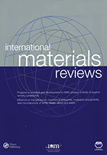
INTERNATIONAL MATERIALS REVIEWS
Your Gateway to Cutting-Edge Materials ReviewsINTERNATIONAL MATERIALS REVIEWS, published by SAGE Publications Inc, is a leading journal dedicated to the comprehensive analysis of contemporary research in the fields of materials chemistry, mechanical engineering, mechanics of materials, and the study of metals and alloys. With an impressive impact factor and a Q1 ranking across multiple categories such as Materials Chemistry and Mechanical Engineering in 2023, it ranks amongst the top journals for innovative materials research. The journal has a long-standing history since its inception in 1987 and continues to serve as a crucial resource for academics and professionals alike. Although it is not open access, it is renowned for its rigorous peer-review process and its commitment to disseminating high-quality materials science research globally. Researchers, students, and industry professionals benefit greatly from the journal's insightful reviews, both for the advancement of theoretical knowledge and practical applications within the fast-evolving materials field.
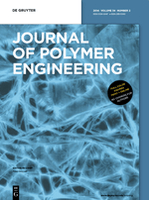
JOURNAL OF POLYMER ENGINEERING
Innovating Solutions Through Polymer Engineering.JOURNAL OF POLYMER ENGINEERING, published by Walter de Gruyter GmbH, stands as a pivotal platform in the field of polymer science and engineering. With an ISSN of 0334-6447 and an E-ISSN of 2191-0340, this journal has been a vital contributor to the academic landscape since its inception, spanning publications from 1981 to 2024. As a recognized entity in the realms of Chemical Engineering, Materials Chemistry, and Polymers and Plastics, it holds a respectable position in Q3 quartile rankings according to the latest assessments. The journal is positioned to promote the exchange of cutting-edge research findings, technological advancements, and critical reviews that address the complexities of polymer application and innovation. Researchers and professionals will find a wealth of information, from experimental methodologies to theoretical analyses, all designed to inspire and elevate the current understanding of polymer engineering. By fostering collaboration and dissemination of knowledge, the JOURNAL OF POLYMER ENGINEERING remains crucial for advancing research and education in its specialized domains.

CCS Chemistry
Showcasing Excellence in Chemical Science and InnovationCCS Chemistry, published by the esteemed Chinese Chemical Society, is a leading open-access journal dedicated to advancing the field of chemistry. Since its inception in 2019, the journal has rapidly gained recognition, achieving a remarkable impact factor that places it in the prestigious Q1 category in Chemistry (Miscellaneous) as of 2023. With a Scopus ranking of #41 out of 408 in General Chemistry, CCS Chemistry represents the top 10th percentile in its category, reflecting its commitment to high-quality research and innovation. The journal serves as a vital platform for researchers and professionals to share their findings, showcase cutting-edge methodologies, and engage with the latest developments in various chemistry subfields. Accessible to a global audience, CCS Chemistry ensures that groundbreaking research is available without barriers, making it an indispensable resource for students and academics aiming to stay at the forefront of chemical sciences. For further details, submissions, and access to published articles, please visit the journal's website.
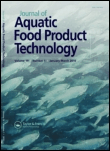
Journal of Aquatic Food Product Technology
Innovating the intersection of aquatic life and food technology.Journal of Aquatic Food Product Technology is a vital publication dedicated to advancing research and innovation in the fields of aquatic science and food technology. Established in 1992 and published by TAYLOR & FRANCIS INC, this journal provides an exceptional platform for researchers, professionals, and students to share their findings and insights on the science and technology surrounding aquatic food products. With an ISSN of 1049-8850 and an E-ISSN of 1547-0636, the journal caters to a global audience, contributing to significant advancements in both the agricultural and biological sciences. As of 2023, it holds a prestigious position in the Q3 quartile for both Aquatic Science and Food Science categories, reflecting its role in the scientific community. Furthermore, with Scopus rankings placing it at #106 out of 247 in its field, this journal is an essential resource for those dedicated to understanding and innovating in the domain of aquatic food products. Although not an open access journal, it ensures that the important research it publishes is accessible to a wide audience interested in improving food safety, sustainability, and nutrition from aquatic sources.
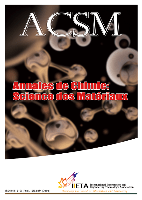
ANNALES DE CHIMIE-SCIENCE DES MATERIAUX
Driving Innovation in Materials Chemistry ResearchANNALES DE CHIMIE-SCIENCE DES MATERIAUX, published by the International Information & Engineering Technology Association, serves as a significant resource in the field of materials chemistry. With an ISSN of 0151-9107 and an E-ISSN of 1958-5934, this journal has been contributing to the scientific discourse since its inception in 1947. The journal is classified in the Q3 category for Materials Chemistry in 2023, positioning it within the 29th percentile in the Scopus ranking for materials science, underscoring its commitment to advancing knowledge and innovation in this vital area of research. Although currently not an open access publication, the journal welcomes submissions that explore a broad range of topics related to material science, thereby facilitating discussions that can lead to groundbreaking discoveries. Researchers, professionals, and students are encouraged to engage with the journal to stay at the forefront of materials chemistry, especially given its historical context and ongoing relevance in academic and industrial applications.
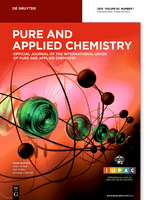
PURE AND APPLIED CHEMISTRY
Unveiling the Practical Side of ChemistryPURE AND APPLIED CHEMISTRY is a highly regarded journal in the fields of chemical engineering and general chemistry, published by Walter de Gruyter GmbH. Since its inception in 1960, this journal has continued to foster advancements in chemical research and facilitate the dissemination of new knowledge through its rigorous peer-reviewed articles. With an impressive impact factor that places it in Q2 quartile rankings for both Chemical Engineering and Chemistry as of 2023, it holds a significant position in the academic landscape, attracting authors and contributors from around the globe. The journal’s unique focus on the practical applications of chemical research makes it indispensable for researchers, professionals, and students aiming to bridge theoretical knowledge with real-world applications. Although it is not open access, its impact is enhanced by its continued relevance and contributions to the ever-evolving field of chemistry. Researchers and practitioners alike will find in PURE AND APPLIED CHEMISTRY a critical resource for staying updated on key developments and innovative practices in chemistry and chemical engineering.

Vietnam Journal of Chemistry
Fostering Global Collaboration in ChemistryVietnam Journal of Chemistry, published by WILEY, is a prominent academic journal that serves as a platform for the dissemination of innovative research in the field of chemistry. With its ISSN 0866-7144 and E-ISSN 2572-8288, this journal has made a significant impact on the global scientific community, evidenced by its 2023 Scopus ranking as #274 in the General Chemistry category and a commendable percentile of 32nd. The journal, categorized in the Q3 quartile for miscellaneous chemistry subjects, aims to foster communication among chemists from Vietnam and around the world, encouraging collaboration and the exchange of cutting-edge knowledge. While it currently does not offer Open Access options, the Vietnam Journal of Chemistry is committed to contributing valuable insights from its coverage years spanning from 2018 to 2024, making it a worthy resource for researchers, professionals, and students dedicated to advancing the field of chemistry. Based in the United Kingdom, it stands as a testament to the vibrant research endeavors emerging from Vietnam and beyond.

ENVIRONMENTAL ENGINEERING SCIENCE
Exploring innovations in environmental science and engineering.ENVIRONMENTAL ENGINEERING SCIENCE is a leading journal published by MARY ANN LIEBERT, INC that provides a platform for pioneering research in the fields of environmental chemistry, pollution control, and waste management. With an ISSN of 1092-8758 and an E-ISSN of 1557-9018, this peer-reviewed journal aims to disseminate high-quality scientific studies that address critical environmental challenges. As evidenced by its 2023 category quartile rankings, it holds a notable position at Q3 in Environmental Chemistry and Pollution and Q2 in Waste Management and Disposal, highlighting its relevance and impact in these domains. Spanning over two decades from 1997 to 2024, the journal is dedicated to fostering innovations and promoting rigorous scholarship that can contribute significantly to sustainable environmental practices globally. Authors and researchers are encouraged to engage with this essential resource, which offers Open Access options to enhance the visibility and reach of their work. For those interested in advancing their understanding and practice within the environmental sciences, ENVIRONMENTAL ENGINEERING SCIENCE is an indispensable journal to consider.
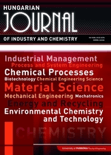
Hungarian Journal of Industry and Chemistry
Transforming Ideas into Chemical SolutionsHungarian Journal of Industry and Chemistry, published by UNIV PANNONIA, has long been a cornerstone in the fields of industrial and chemical research since its inception in 1974. With a focus on integrating innovative studies and applications within the chemical industry, this journal serves as a vital platform for researchers and practitioners aiming to disseminate their findings and advancements in both theoretical and practical domains. Although its coverage in Scopus has been discontinued post-2002, it continues to be an essential resource for students and professionals seeking insights into the transformative practices and developments in chemistry and industry. The journal's commitment to fostering academic discourse is reflected in its compelling array of articles, making it indispensable for anyone engaged in the evolving landscape of industrial chemistry.